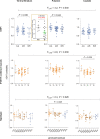The dopamine transporter gene SLC6A3: multidisease risks
- PMID: 34650206
- PMCID: PMC9008071
- DOI: 10.1038/s41380-021-01341-5
The dopamine transporter gene SLC6A3: multidisease risks
Abstract
The human dopamine transporter gene SLC6A3 has been consistently implicated in several neuropsychiatric diseases but the disease mechanism remains elusive. In this risk synthesis, we have concluded that SLC6A3 represents an increasingly recognized risk with a growing number of familial mutants associated with neuropsychiatric and neurological disorders. At least five loci were related to common and severe diseases including alcohol use disorder (high activity variant), attention-deficit/hyperactivity disorder (low activity variant), autism (familial proteins with mutated networking) and movement disorders (both regulatory variants and familial mutations). Association signals depended on genetic markers used as well as ethnicity examined. Strong haplotype selection and gene-wide epistases support multimarker assessment of functional variations and phenotype associations. Inclusion of its promoter region's functional markers such as DNPi (rs67175440) and 5'VNTR (rs70957367) may help delineate condensate-based risk action, testing a locus-pathway-phenotype hypothesis for one gene-multidisease etiology.
© 2021. The Author(s).
Conflict of interest statement
The authors declare no competing interests.
Figures






Similar articles
-
Neuropsychiatric disease-associated genetic variants of the dopamine transporter display heterogeneous molecular phenotypes.J Biol Chem. 2018 May 11;293(19):7250-7262. doi: 10.1074/jbc.RA118.001753. Epub 2018 Mar 20. J Biol Chem. 2018. PMID: 29559554 Free PMC article.
-
Association of the dopamine transporter (SLC6A3/DAT1) gene 9-6 haplotype with adult ADHD.Am J Med Genet B Neuropsychiatr Genet. 2008 Dec 5;147B(8):1576-9. doi: 10.1002/ajmg.b.30861. Am J Med Genet B Neuropsychiatr Genet. 2008. PMID: 18802924
-
An association between a dopamine transporter gene (SLC6A3) haplotype and ADHD symptom measures in nonclinical adults.Am J Med Genet B Neuropsychiatr Genet. 2015 Mar;168B(2):89-96. doi: 10.1002/ajmg.b.32283. Epub 2015 Feb 5. Am J Med Genet B Neuropsychiatr Genet. 2015. PMID: 25656223
-
Polymorphisms of the dopamine transporter gene: influence on response to methylphenidate in attention deficit-hyperactivity disorder.Am J Pharmacogenomics. 2004;4(2):83-92. doi: 10.2165/00129785-200404020-00003. Am J Pharmacogenomics. 2004. PMID: 15059031 Review.
-
Relationship between SLC6A3 genotype and striatal dopamine transporter availability: a meta-analysis of human single photon emission computed tomography studies.Synapse. 2011 Oct;65(10):998-1005. doi: 10.1002/syn.20927. Epub 2011 Mar 28. Synapse. 2011. PMID: 21404331 Review.
Cited by
-
A Novel and Selective Dopamine Transporter Inhibitor, (S)-MK-26, Promotes Hippocampal Synaptic Plasticity and Restores Effort-Related Motivational Dysfunctions.Biomolecules. 2022 Jun 24;12(7):881. doi: 10.3390/biom12070881. Biomolecules. 2022. PMID: 35883437 Free PMC article.
-
Dopamine Transporter Deficient Rodents: Perspectives and Limitations for Neuroscience.Biomolecules. 2023 May 9;13(5):806. doi: 10.3390/biom13050806. Biomolecules. 2023. PMID: 37238676 Free PMC article. Review.
-
New Insights Into the Human Dopamine Transporter: Structure, Function, and Therapeutic Potential.MedComm (2020). 2025 Apr 14;6(5):e70187. doi: 10.1002/mco2.70187. eCollection 2025 May. MedComm (2020). 2025. PMID: 40242158 Free PMC article. No abstract available.
-
A DAT1 gene and APOE ε4 interaction is associated with apathy and structural brain changes in mild cognitive impairment and Alzheimer's disease.J Alzheimers Dis. 2025 Jan;103(1):230-242. doi: 10.1177/13872877241299785. Epub 2024 Nov 29. J Alzheimers Dis. 2025. PMID: 39610284 Free PMC article.
-
Deficiency of transmembrane AMPA receptor regulatory protein γ-8 leads to attention-deficit hyperactivity disorder-like behavior in mice.Zool Res. 2022 Sep 18;43(5):851-870. doi: 10.24272/j.issn.2095-8137.2022.122. Zool Res. 2022. PMID: 36031768 Free PMC article.
References
Publication types
MeSH terms
Substances
Grants and funding
LinkOut - more resources
Full Text Sources
Medical

